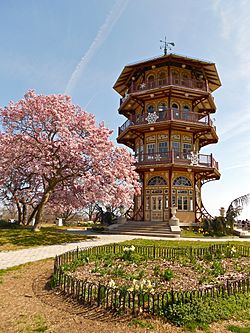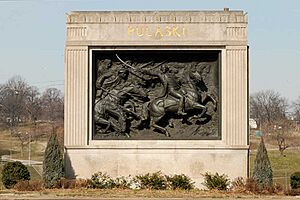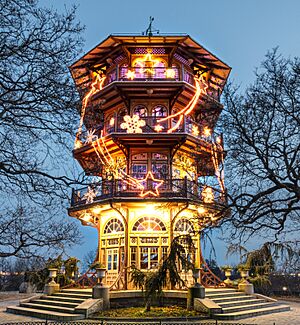Patterson Park facts for kids
Quick facts for kids Patterson Park |
|
|---|---|

The "Observatory" a pagoda-style building on Hampstead Hill, overlooking the rest of the park
|
|
| Type | Public park |
| Location | Baltimore, Maryland |
| Created | 1827 |
Patterson Park is a big, fun urban park in Baltimore, Maryland. It's located in Southeast Baltimore, right next to neighborhoods like Canton and Highlandtown. The park is bordered by streets like East Baltimore Street and Eastern Avenue.
This park was created in 1827. It was named after William Patterson, an important person from Baltimore. Patterson Park has wide-open grassy areas, tall trees, and paved paths. You can also find historic spots, a lake, playgrounds, and sports fields here. There's even a swimming pool and an ice skating rink!
Patterson Park is about 137 acres (0.55 km2) in size. It's often called the "Best Backyard in Baltimore" because it offers so much to do.
Contents
Fun Things to Do at Patterson Park
Patterson Park has four main entrances, one at each corner. There are many cool things to see and do inside!
Park Attractions
- Boat Lake: You can go fishing in the boat lake. It's a peaceful spot to relax.
- Marble Fountain: A beautiful fountain adds to the park's charm.
- Pulaski Monument: This monument honors Casimir Pulaski, a hero from history.
- Patterson Park Pagoda: This unique building was first called the Patterson Park Observatory. It was built in 1891 as a tall tower to see great views of the city. You can still visit it today!
- Virginia S. Baker Recreation Center: This center offers more activities for visitors.
Activities for Everyone
The park has smooth paths, perfect for biking or jogging. If you love sports, the fields are open for games. There are also public tennis courts. For younger kids, there are two playgrounds. Dogs can have fun too in a special fenced-in dog park.
During summer, you can cool off at the swimming pool. In winter, the ice skating rink is open for chilly fun. Many festivals are held in the park from spring to early autumn. The neighborhoods around the park are also being improved by city leaders.
Nature and Wildlife
While Patterson Park doesn't have thick forests, it has lots of open green spaces. The boat lake was recently rebuilt. It's home to many mallard ducks. You might also spot other birds like American coots and wood ducks. Sometimes, large birds like Great blue herons and great egrets visit the lake. The lake also has fish, frogs, and turtles living in it.
A Look Back: Patterson Park's History
Patterson Park has a rich history, especially during important wars.
The War of 1812
The highest part of Patterson Park is called Hampstead Hill. This spot was very important for the U.S. forces during the Battle of Baltimore in the War of 1812. It was a key defense point against British ground forces. A strong dirt wall, called a redoubt, was built here. It was named Rodgers Bastion or Sheppard's Bastion. This wall helped protect Baltimore from the east.
On September 13, 1814, British troops marched towards Baltimore. U.S. troops had to retreat to this strong defense line. The American defenses were much stronger than the British expected. Also, U.S. defenders at Fort McHenry stopped the British ships from getting close enough to help. Because of this, the British commander decided to retreat on September 14, 1814. The United States won the Battle of Baltimore!
Park Development Over Time
William Patterson gave 5 acres (0.02 km2) of land to the city in 1827 for a public park. The city bought another 29 acres (0.12 km2) from the Patterson family in 1860. More land was added later, making the park its current size of 137 acres (0.55 km2). Money for park improvements came from a special "park tax" on streetcars.
During the American Civil War, the park was used as a camp for Union soldiers. For many years, some park areas like swimming pools and playgrounds were kept separate for different groups of people. This changed in 1956 when they were opened to everyone. Patterson Park is now part of the Baltimore National Heritage Area.
In 1962, President Kennedy even visited the park! He landed his helicopter there and then rode in an open car to a local armory. He was in town to support Democratic candidates before an election.
The Famous Patterson Park Pagoda
The Patterson Park Pagoda is a 60-foot (18 m) tall tower. It was designed in 1890 and finished in 1892. Charles H. Latrobe, an engineer, and George A. Frederick, an architect, designed it. They wanted it to be a lookout tower for people to enjoy the views. Its Asian-inspired look came from Latrobe's interest in Eastern designs. The Pagoda became a Baltimore City historic landmark in 1971.
Images for kids
See also
 In Spanish: Parque Patterson para niños
In Spanish: Parque Patterson para niños



